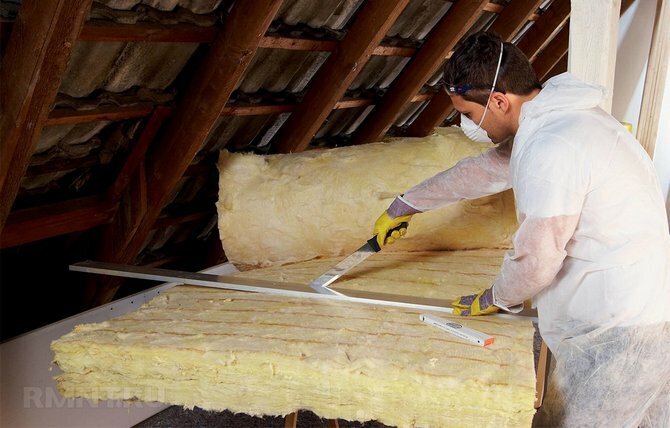Laying work concrete always required physical strength and patience. If the site was poured under a parking lot, a warehouse or any other facility where people will work, then the concrete floor is always polished. This is a labor-intensive business, you will need a special tool, patience and accuracy when processing cement stone.
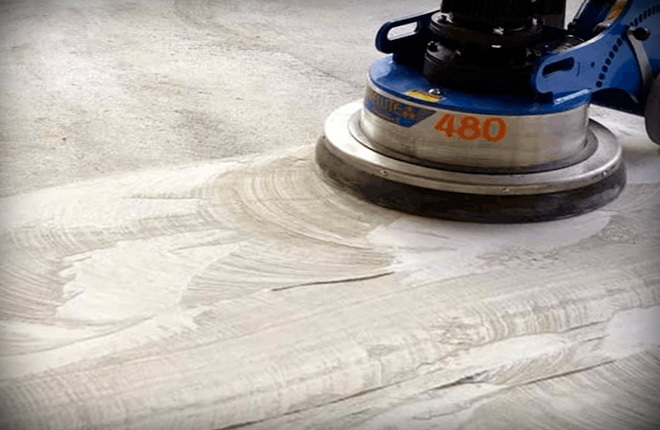
The content of the article:
- What is grinding for?
-
Methods for cleaning concrete
- Characteristics of concrete
- Dry sanding
- Emulsion treatment
- Tool
- Equipment
-
Sanding instructions
- Preparation
- Checking the concrete floor before sanding
- Grinding the concrete base
-
Common mistakes and how to avoid them
- Tool overheating
- Grinding with worn tools
- Wrong grinding path
- How to eliminate defects after grinding
What is grinding for?
Sometimes you can hear the opinion that the procedure for grinding concrete floors is needed to give the surface a more sophisticated look. If we are talking about decorative floors filled with marble or limestone chips (crushed stone), then concrete grinding can really level the surface and prepare it for final polishing.
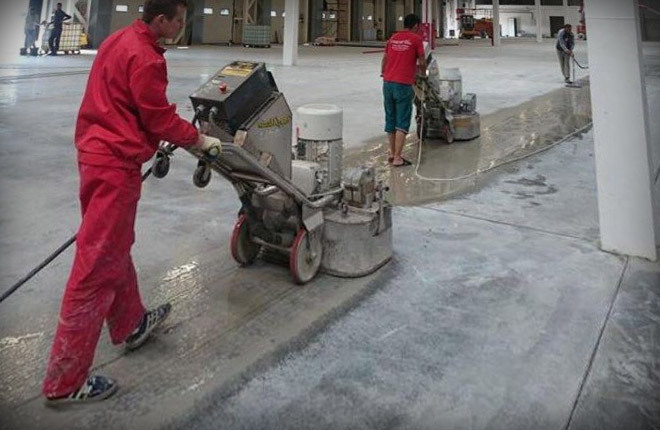
Such a scheme for constructing concrete floors is often used in shops, indoor areas, wherever, according to the norms of SNiP, a certain quality of the surface of the concrete floor is required. Moreover, many stores and trade enterprises, according to sanitary standards, must carry out regular wet cleaning of the floor. Grinding concrete will provide not only a flat floor, but also a sufficiently high-quality coating.
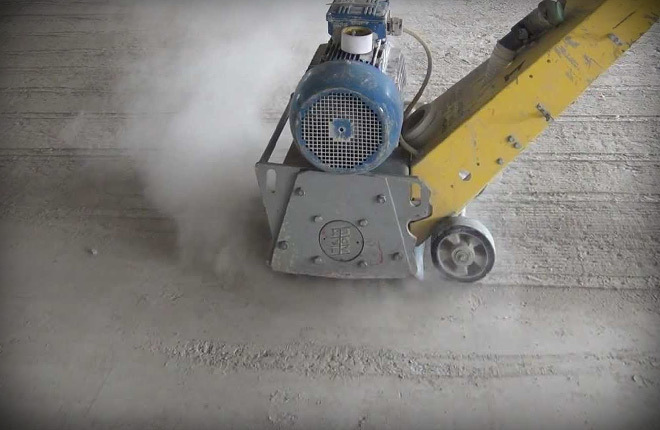
At a construction site, warehouses and production workshops, there is no question of any decorative form, where is the construction site, and where is the interior. During the construction of a large warehouse, parking lot or workshop, floor grinding is performed for prosaic reasons:
- Pouring concrete over a large area is performed in several sessions. The quality of the mixture, its plasticity, spreadability and shrinkage may vary. Therefore, after unloading 5-6 concrete mixers on the base, after setting, protruding nodules, humps, joints and seams from the formwork will remain on the concrete surface. All imperfections will need to be sanded down.
- The top layer of the concrete surface is always of poor quality. The floor is covered with cracks, dust from sand and cement. Without grinding, all this will crumble under the feet and wheels of vehicles. Therefore, the surface must be sanded.
- Customers of the object, especially if it is a production workshop, lay in the requirements a certain quality of the surface of the concrete floor. Grinding is required for subsequent dedusting and painting of concrete floors.
Many private owners - owners of their own garages or workshops also prefer to do floor grinding indoors. Even if additional finishing is not planned. This is not just a tribute to fashion, but compliance with safety regulations.
You can easily catch your shoes on a protruding defect on the concrete floor and get seriously injured. Therefore, high-quality grinding of the floor is just as important as laying concrete on the site.

Methods for cleaning concrete
The choice of concrete floor grinding technology directly depends on the concrete, the requirements for surface quality and the capabilities of the grinder. In the simplest case, at home, a concrete floor can be sanded with an ordinary grinder with a grinding nozzle. In order not to suffocate from concrete dust, grinding will need to be done with a side blown fan, or use a construction vacuum cleaner.
On an industrial scale, manual grinding usually eliminates small defects in corners and hard-to-reach places. The main part of the work can be done in 2 ways:
- With the supply of water emulsion to the working area of the grinding wheel. This is a wet sanding option.
- Without emulsion, concrete surface grinding is carried out without water. This is the dry way.
- Combined treatment option, pre-treatment without water, final grinding is carried out with an emulsion.
The specific method is selected depending on the scope of work, the required surface quality and grinding speed. The combined method usually grinds very old, poor quality concrete floors with a lot of potholes and repair patches.
Characteristics of concrete
The highest quality concrete floor is obtained on heavy high-quality concrete. If the site is poured for further processing, then concrete grade M200 is used. If the project has additional requirements for the hardness of the floor, then it will be filled with a mixture of M300. Such a coating is difficult to process even with a specialized tool, but the result is a sufficiently high-quality surface that can be brought to a smooth state.
Covered platforms and hangars for transport can be filled with concrete mixtures M150-M200. Grinding such concrete is carried out at a lower cost, but it will be necessary to give more time to set and harden the coating, otherwise cracks and potholes may appear under heavy load.
In any case, before grinding the floor surface, you need to:
- Check for cracks and areas with protruding reinforcement (if any).
- Treat with a special mortar that makes the surface of a fresh concrete floor denser and harder.
These are the so-called concrete mass hardening accelerators. There are many options for the mixture, but usually calcium chloride is used for ordinary concrete.
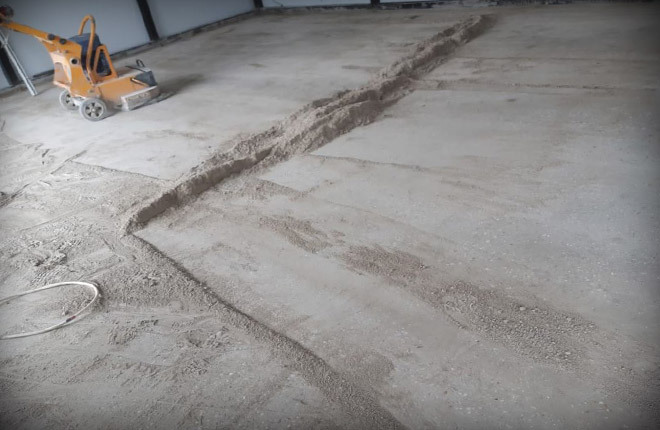
Dry sanding
The process is carried out without water or emulsion. Therefore, the tool of the grinder raises a huge amount of dust into the air. To get rid of the dust cloud, the exhaust sleeve of a construction vacuum cleaner is connected to the lining of the grinding wheel.
Dry grinding of concrete is considered to be simpler and more convenient, since it is possible to control the quality of the surface directly in the process of work. Different parts of the floor may differ in characteristics, so it is important to constantly check how deep the working tool cuts concrete, whether there are risks and chips.
Dry sanding of light concretes, as well as floors with decorative filler. Sometimes, before the final stage of grinding, the concrete surface is slightly moistened with water. This is done in order to reduce the heating of cast iron cups or other cutting tools. As a result, the surface quality after grinding is improved.
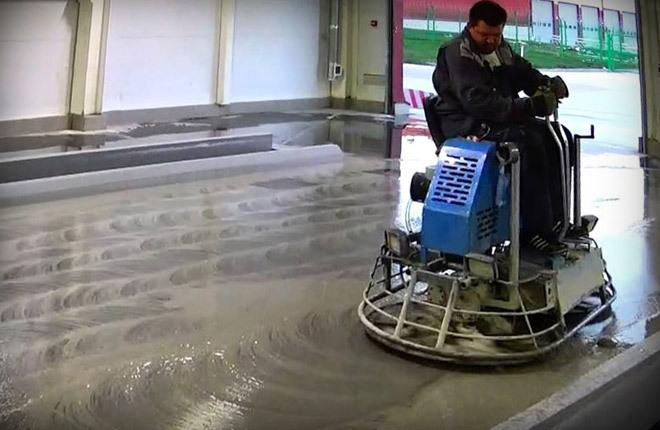
Emulsion treatment
The wet method involves the use of water with the addition of a small amount of liquid polymer. During the grinding process, the cutting edge is very hot, and the addition of water reduces wear and the risk of corrosion. In addition, there is a risk of overheating the concrete surface, which can lead to cracks in the floor.
Water is sprayed by a special nozzle inside the grinder. It is not recommended to spray the emulsion with your own hands on the cutting tool. This will not improve the quality and may cause stains on the floor.
The rotational speed of the tool is higher when wet, so you can either grind at maximum productivity or set the machine up for a better surface finish. On old heavy concrete floors, even a slight gloss can be achieved.
In addition, wetting somewhat improves working conditions, grinding goes with less noise and less dust raised into the air.
The only disadvantage of the wet method is the appearance of a huge amount of viscous wet sludge - a mixture of concrete dust and emulsion. It has to be removed in order to evaluate the quality of grinding.
Tool
It is selected depending on the required surface quality and the equipment used. The easiest option is replaceable grinding wheels for angle grinders.

The grinding tool may be simple, for example, in the form of petals mounted on a cast iron base. It is used for finishing grinding of concrete in hard-to-reach places.
Most concrete grinding tools are made from bronze and cast iron. Usually a circle in profile has the shape of a cup, so in everyday life it is called that - grinding cups. The cutting edge is formed by milling the wheel body.
Petals can be arranged in 1-2 rows, have the form of helical gearing. Most often, the cutting surface is made in the form of a two-row chain of sectors.
On powerful grinders, circles or “stones” are installed with a round base made of cast iron, the cutting edge is already made in the form of oblique blades or trapeziums - Frankfurt. Such a tool makes it possible to grind the concrete floor at a higher speed, with the capture of the material to the maximum depth.
Preliminary grinding is carried out with cutters with carbide inserts or coarse grit abrasive (No. 40-No. 60). With such a tool, a rough peeling of "humps" and protruding rubble is carried out.
Next, cast-iron cups with a grain of 400 units are used, at the last stage - 800-1300 units.

For fine grinding, cast-iron cutters with diamond grit are used. This tool can process heavy concrete with granite or basalt filler.
Equipment
Several types of equipment can be used for grinding. The most affordable option is a corner machine, but its capabilities are enough for a maximum of several square meters of a concrete floor.
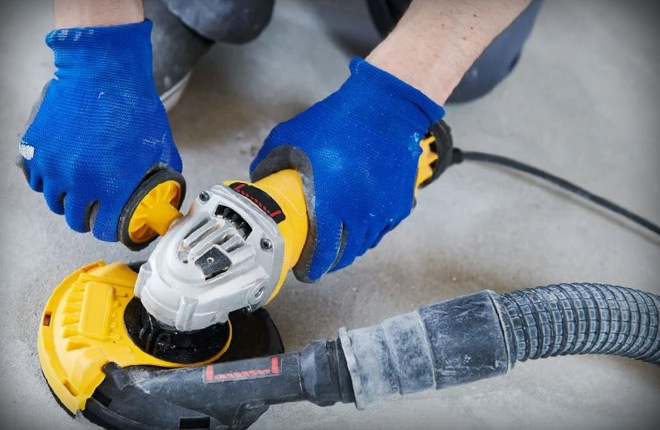
Complete grinding of the concrete site is performed by electric or more often gasoline machines. As a rule, the floor is treated simultaneously with 3-4 cups at once. If you grind with one circle, then the scratches will remain on the surface, while the processing plane may be slightly uneven. Three simultaneously working circles cut off more concrete mass, but the main thing is still the alignment of the grinding plane.
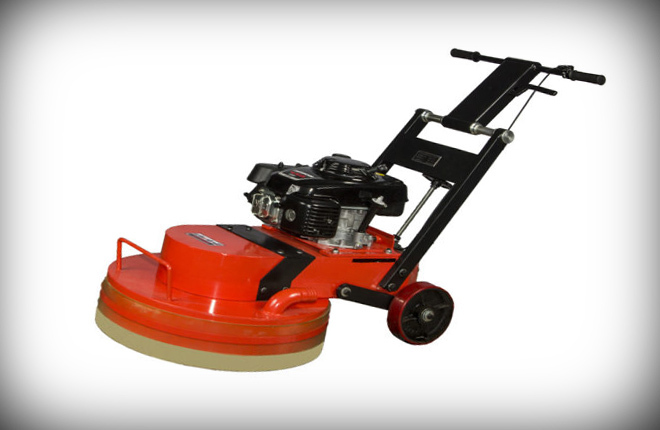
With each pass over the concrete floor, its quality improves, the surface plane is leveled, slopes and waves are eliminated. For fine grinding, heavier machines with air-cooled tools are used.
At the final stage, light ironing or polishing machines are used, in which the heavy cast-iron frankfurt is replaced with a soft circle. The rotation speed increases, grinding turns into smoothing. In this case, the defects are not cut off, but smoothed into the surface of the concrete floor.
Sanding instructions
After pouring, the concrete floor must gain the necessary strength and hardness. This process has been going on in concrete for decades, only after 60-70 years of operation the material begins to degrade.
The first stage of hardening ends after 6-7 days. If heavy concrete was used, then after a week you can start preparing the concrete floor. Ideally, rough sanding can begin 20-21 days after pouring. It does not make sense to go out with the instrument earlier.
For the most impatient, we can advise you to take measurements during this time, apply markings on the surface - where there are humps and pits. Depending on the location of defects on the concrete floor, the appropriate grinding scheme is selected.
Preparation
A fresh concrete floor usually has a minimum of defects, but this does not mean that cracks and chips will not appear in the future. The main shrinkage (by 70-80% of the total) ends after 3 days. But the beginnings of future cracks will be visible immediately. At the same time, it is necessary to check the places where the reinforcement mesh could rise. They need to be marked, but it will be necessary to cut or knock out random debris from the frozen floor no earlier than the concrete floor gains full strength.
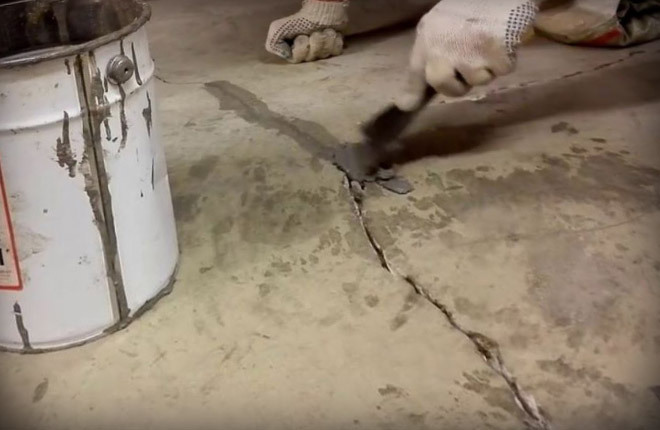
The exception is metal objects. They need to be cut with a grinder with a cutting disc for concrete immediately, immediately. If the time has passed no more than a day, then you can fill in the repair patch.
On old concrete floors, cracks, potholes, chips are cut out with a grinder so as to remove at least 5 mm of whole concrete from the walls. In this way, it is usually possible to remove damage to the concrete mass, from which cracks and chips could continue to develop. Before pouring the repair mixture, it is advisable to coat the crack with a deep penetration primer. The repair mass is poured with liquid, on top it will be necessary to leave a “top”, which should compensate for the shrinkage of fresh concrete.
After a week, it must be cut off with a grinder and sanded to the level of the main floor surface. In the same way, all other cracks and defects on the concrete surface will need to be rubbed and sanded.
It doesn't matter if it's an old concrete floor with a painted surface or a fresh screed, there are always defects and slopes on the site. On old concrete, such as the floor of a garage or warehouse, abrasion of the surface occurs from the soles of shoes or the wheels of vehicles.
If desired, you can even see the tracks from the workings on the floor. The height difference usually does not exceed 7-8 mm, but on very old sites, the wear of the concrete floor can be up to the reinforcement grid. Before grinding, such surfaces must be restored with the laying of a metal mesh, the ends of which are tied up with old reinforcement.
Checking the concrete floor before sanding
The next stage is considered the most difficult in the entire process of preparing for grinding. It is necessary to determine the actual geometry of the surface of the concrete screed. This must be done in advance in order to draw up a grinding map. This will help to choose the right starting areas for grinding at the initial stage.
You can check the profile of the concrete floor in a small room using masking cords stretched across the room between the baseboards. The plinths themselves will need to be removed, the position of the stretched cord should be adjusted according to the building level.
A laser level with 1-2 beams is considered more convenient to use. Usually, the lowest point of the concrete floor surface is selected before measurement. This will be the base surface. From here you can start grinding if the plane does not have a pronounced large slope to one side. Such a defect is often found when pouring a concrete floor by hand inside the finished room.
After installing the laser level, you need to measure the distance from the beam along the concrete surface with a ruler every 50-70 cm in the longitudinal and transverse directions. If you transfer the measurements to the floor plan, you get a map of the surface of the concrete site.
The day before the start of grinding, the concrete floor must be cleaned of debris, wiped dry and treated with a strengthening suspension. The solution is best applied to the surface with a paint roller. That way it gets faster. Moreover, the liquid will need to be applied several times.
This is usually done before changing tools:
- Before rough sanding, leveling, grouting defects and cutting slopes.
- Before finishing grinding the concrete floor, Frankfurts are changed to cups with abrasive.
- Semi-finished floor grout.
- Before polishing a concrete floor to a high gloss.
You can also save on impregnating solution. For example, when sanding a concrete parking area or parking space, or if additional flooring is planned to be laid over concrete. But for interiors, where the concrete floor will be finished, slurry polishing is considered mandatory.
Grinding the concrete base
As a rule, on fresh floors, work does not begin with rolling out the grinder. At the first stage of grinding, first of all, it is necessary to cut off coarse point defects and humps. The largest defects can be knocked down with a hammer and chisel. If there are a lot of them, for example, there is a whole strip of "scallops" left after the formwork boards, then it is better to use an electric jackhammer. Defective areas often have to be sanded by hand, using a grinder and a pair of abrasive discs.
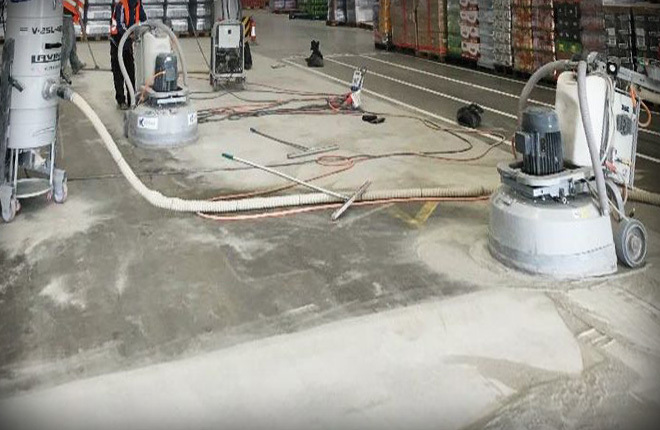
You can try to immediately cut off the defective area with a grinder, but this is not always convenient. The capture band of a powerful device is wide in order to remove a defect of a couple of centimeters. Often, because of the protective skirt, the master simply does not see the place where the “bump” needs to be cut.
The cutting tool provides high quality grinding only if the load is stable. It doesn't matter if 1 circle is used or 3. Cutting a defect on a concrete floor using the “poke” method is dangerous, you can easily pick holes and make chips on the concrete.
If this is the first experience of grinding concrete, then it is better to start working with a grinder from an area where the floor surface is as even and flat as possible. The machine must be adjusted for floor load and travel speed. Since concrete will be removed from the entire surface of the site by grinding, you can not be afraid to spoil the floor. 5 to 10 mm will need to be removed over the entire area, so a little check of the operation of the machine on the most even area will not spoil the results of grinding the concrete floor.
After setting up, the grinder is brought to a corner or to the edge of the highest “hump” and grinding is performed in continuous continuous strips, as in the video:
Periodically every 15-20 minutes, the machine is stopped to remove sludge or dust, check the surface quality of the concrete floor and allow the tool to cool.

Before you start grinding, it will be useful to ask about the working cycle of the machine, how long the machine can run continuously, and how often it needs to be stopped for cooling.
If you plan to process large areas, then it is better to rent industrial equipment. With it, you can not only grind faster, but also with a higher level of surface quality.
Common mistakes and how to avoid them
According to the masters, the understanding of what exactly was done wrong comes after the completion of the work. Grinding a concrete floor is difficult, long, you have to return to an already treated surface to eliminate defects.
Tool overheating
The cutting edges of the wheel experience a huge abrasive load, so even a powerful tool can become very hot during the grinding process. Even if the car has a built-in blower fan. Therefore, mainly small areas are ground with a dry method, large surfaces are treated with a wet method.
In addition to the tool, the motor and gearbox overheat. The power and rotational speed are reduced, which means that the quality of concrete grinding decreases. Therefore, you need to look in the instructions - what area the grinder is able to process without reducing quality. If the equipment is overheated, it is advisable to tip it on its side and let it cool for 10-15 minutes.
Grinding with worn tools
Experienced craftsmen work on the concrete floor with several sets of circles. The tool gradually wears out, respectively, performance sags. Pressing on the machine to increase the speed of grinding is pointless, as well as loading it with additional ballast. Both the apparatus itself and the concrete surface will suffer from this.
In addition, in the early stages of grinding, when it is necessary to cut off the thickest ridges and humps, the tool may wear unevenly. As a result, spirals and snakes appear on the polished surface. If a picture appears, indicating that the circle cuts concrete with only one working edge (instead of 4-5), then you need to make a replacement.
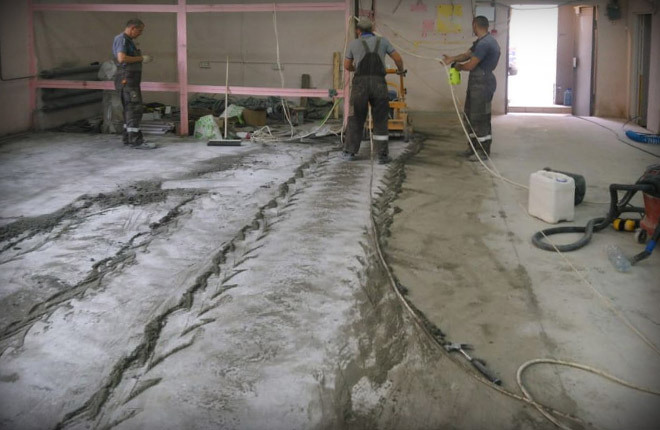
Of great importance is the practical skill of handling a grinder. Experienced workers can determine by force and sound the moment when the tool is worn out and needs to be replaced.
Wrong grinding path
Pre-sanding always starts on a flat surface, near the largest hump or highest point of the concrete floor. The main task is to cut off the protruding surfaces, bring them to one average level.
Therefore, at the preliminary stage, grinding is performed in circles around such a “hill”, gradually approaching the top. If you grind in successive strips, then the defect will not disappear anywhere. Periodically, you need to turn on the laser level and check with a ruler how even the concrete floor has become.
If the surface of the concrete site does not have a pronounced slope, but is dotted with small "holes", then it is better to use the "mower" scheme. In this case, grinding starts in the far corner, and the trajectory of the machine resembles a periodic movement in an arc. Approximately how a hand scythe works when mowing grass.
The last step is to flatten the concrete floor. Grinding is done in strips, much like a lawn mower works on a lawn. At the end of the work, you will need to check the level of the floor surface, and you can proceed to the decorative finish.
How to eliminate defects after grinding
The most common problem is the marks and traces of the tool. The easiest way to remove defects is to grind them with a finer finish. If the site is matte, then it will be enough to refine the concrete with a diamond tool so that a satin sheen appears. After that, a primer is applied to the floor, as a rule, it hides defects, and in general, the concrete looks quite even and flat.
If there are defects on the surface for further polishing, then you need to change the finishing technology. Instead of polishing to gloss, several layers of varnish are laid on the floor with intermediate polishing. As a result, you can completely close the deep risk.
Grinding a concrete floor with your own hands requires patience and attention to the results. There are no technological secrets in the concrete processing procedure, therefore, with careful handling of the equipment, the result will always be rated “good”. Fine work - concrete floor polishing is best left to professionals.
Tell us about your experience of polishing floors - what problems arose, and how were they solved in the process of work? Bookmark this article so you don't lose important information on the topic.
